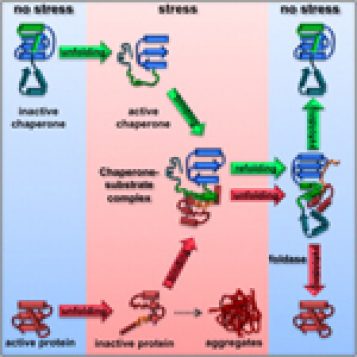Order out of Disorder: Working Cycle of an Intrinsically Unfolded Chaperone:
Dana Reichmann, Ying Xu, Claudia M. Cremers, Marianne Ilbert, Roni Mittelman, Michael C. Fitzgerald, Ursula Jakob
The redox-regulated chaperone Hsp33 protects organisms against oxidative stress that leads to protein unfolding. Activation of Hsp33 is triggered by the oxidative unfolding of its own redox-sensor domain, making Hsp33 a member of a recently discovered class of chaperones that require partial unfolding for full chaperone activity. Here we address the long-standing question of how chaperones recognize client proteins. We show that Hsp33 uses its own intrinsically disordered regions to discriminate between unfolded and partially structured folding intermediates. Binding to secondary structure elements in client proteins stabilizes Hsp33's intrinsically disordered regions, and this stabilization appears to mediate Hsp33's high affinity for structured folding intermediates. Return to nonstress conditions reduces Hsp33's disulfide bonds, which then significantly destabilizes the bound client proteins and in doing so converts them into less-structured, folding-competent client proteins of ATP-dependent foldases. We propose a model in which energy-independent chaperones use internal order-to-disorder transitions to control substrate binding and release.
This paper was featured in the U-M News Service article "It takes two to tango: Pairs of entwined proteins handle the stress."
Name of Periodical: Cell
Volume Number: 148
Issue Number: 5
Year of Publication: 2012


